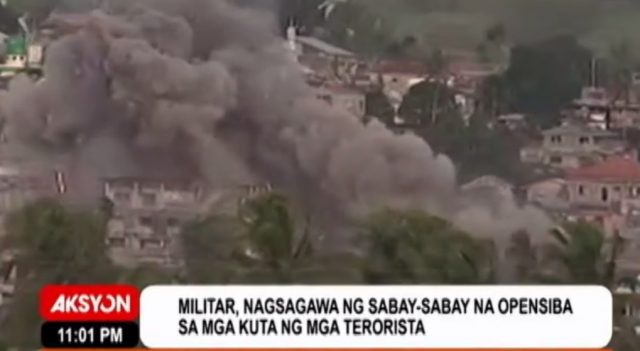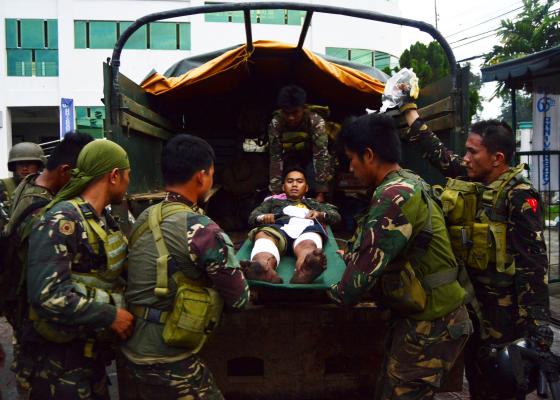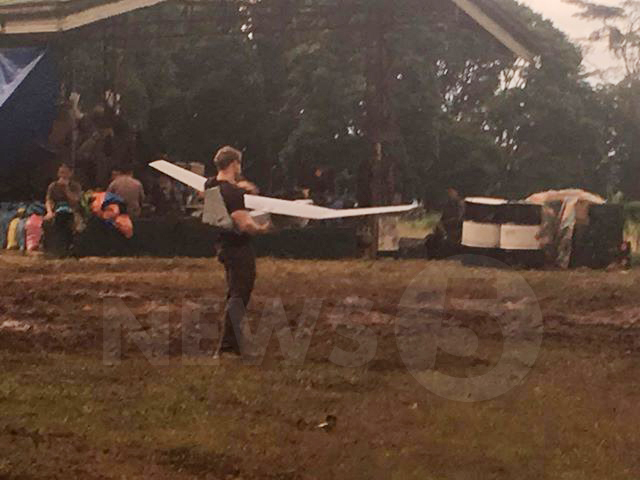
The explosion from a government air strike sends dark smoke and debris up into the air. (image from News5 video)
MARAWI CITY, Philippines — (UPDATE 4 – 2:49 p.m.) The Philippine Marines lost 13 troops in Marawi City Friday in what the military described as an “intense firefight” against extremist gunmen using hostages as human shields well into the night.
The heavy losses, confirmed in a press briefing early Saturday afternoon by Lieutenant Colonel Jo-Ar Herrera, spokesman of Joint Task Force Marawi, followed the wounding of 16 Marines while trying to retake the Mapandi Bridge earlier in the day.
Herrera also acknowledged what the U.S. embassy in Manila had confirmed, that American special forces were assisting the military in Marawi. An embassy spokesperson said the assistance had been sought by the Philippines.
The injured personnel were taken to a medical facility in Iligan City Friday afternoon.

A wounded soldier is loaded onto a military truck for transport from Marawi to Iligan. (PNA photo)
The latest fatalities brought the total loss of lives on the government side to 58 since security forces began battling extremist gunmen from the Maute and Abu Sayyaf groups, accompanied by some foreign fighters, on May 23, when President Rorigo Duterte declared martial law over Mindanao.
The military says more than 130 extremists have been killed. At least 20 civilians have also died.
Herrera also said more troops were wounded while the Marines also inflicted casualties on the extremists during the battle in Barangay Lilod Madaya but could give no immediate figures.
Also among Friday’s fatalities was a 14-year old boy who was hit by a sniper’s bullet as he prayed in a mosque near the headquarters of the 103rd Infantry Brigade at noon.
The officer said the troops of Marine Battalion Landing Team 7 were conducting clearing operations in Lilod Madaya when they were hit by heavy fire that included improvised explosive devices and rocket-propelled grenades from the extremists who had “optimized the use of human shields and mosques,” which they had turned into defensive positions.
He described the fighting as “house-to-house” but government troops were disadvantaged by the need to avoid civilian casualties or damage mosques.
Ambulances rushed in and out of the battle zone most of Friday and firing could be heard from almost all directions, the result, said the military, of simultaneous assaults on terrorist positions.
The spike in hostilities followed the military’s announcement that it hoped to clear Marawi by Monday, Independence Day.
The latest fighting has been marked by continuous air strikes on positions held by the extremists.
The escalating violence also came amid reports that Omar Khayyam Maute, one of two brothers who founded the extremist group named after them, had been killed and that Abu Sayyaf leader Isnilon Hapilon, earlier reported to have fled Marawi, had returned with reinforcements.
Herrera said they were still validating the reports of Omar’s death, which he said apparently happened in an earlier skirmish.
One soldier on a break from Friday’s fighting said they had cornered the extremists but acknowledged the difficulty of finally defeating them because of the cover provided by tall buildings and other structures.
This was evident in a drone video obtained by News5 that showed a group of gunmen entering a building, apparently to use it as a redoubt to attack the assaulting government troops.
In Manila, a US embassy spokesperson told Reuters: “At the request of the government of the Philippines, U.S. special operations forces are assisting the AFP with ongoing operations in Marawi that help AFP commanders on the ground in their fight against Maute and ASG militants.”
Until now there had been no confirmation that the Philippines had sought U.S. assistance in the battle for Marawi City on the island of Mindanao, which is in its third week.

A US special forces soldier with a surveillance drone inside Camp Ranao in Marawi City in a photo obtained by News5.
But Herrera, asked if a specific request had been made for US assistance, said “the presence of (our) US counterparts facilitates (the) exchange of intelligence, subject matter experts, training exchanges, and technical support” as part of “existing agreements (and the) enduring partnership” between the two countries.
He stressed no U.S. troops were involved in combat operations.
However, he refused to comment on the presence of an American P-3 Orion plane that was seen flying over Marawi Friday.
The assistance comes after months of strain between the two long-time allies that was stoked by Philippines President Rodrigo Duterte’s hostility toward Washington and his pledges to throw U.S. troops out of the country.
Washington deployed special forces soldiers to Mindanao in 2002 to train and advise Philippine units fighting Abu Sayyaf militants in a program that once involved 1,200 Americans.
It was discontinued in 2015 but a small presence remained for logistics and technical support.
The United States and the Philippines have been allies for decades. Their relationship provided Washington with a strategic foothold in Asia, and offered Manila a shield against China’s assertiveness in the region.
But Duterte has openly scorned the alliance, seeing it as an obstacle to a rapprochement with China, and has repeatedly lambasted Washington for treating his country as a lackey.
Herrera also justified the use of “surgical” air strikes against the extremists, saying these had “softened and taken down” several strongholds, sniper’s nests and “command and control” centers.
http://www.interaksyon.com/16-troops-wounded-as-fighting-flares-in-marawi/

No comments:
Post a Comment
Note: Only a member of this blog may post a comment.